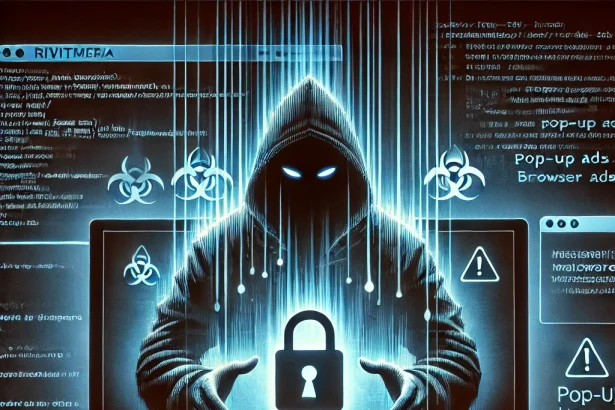Threat Summary
| Category | Details |
|---|---|
| Threat type | Adware / Browser hijacker |
| Associated domain | ced‑adguard.pro |
| Detection names | Ads by ced‑adguard.pro, Phishing |
| Symptoms | Pop-up spam, browser hijack, notifications on closed browser |
| Damage/Distribution | Clickbait notifications, malvertising, adware bundles |
| Danger level | Moderate |
| Recommended Removal | SpyHunter |
Threat Evaluation
How I got infected
You probably clicked a misleading ad or fake “Play/Download” button on an untrustworthy site (streaming, torrent, adult). This redirected you to ced‑adguard.pro, which prompts you with fake CAPTCHAs or video buttons to trick you into allowing notifications.
What does it do
By clicking “Allow,” you grant permission to receive notifications directly on your desktop or mobile—even with the browser closed. The site then floods your device with intrusive pop-ups promoting adult content, fake updates, games, and possibly phishing scams.
Should you be worried
While not directly ransomware or data-stealing malware, this adware is deeply invasive. It degrades browsing experience, could lead you to malicious sites, and may pave the way for more serious infections. It also creates privacy concerns by peppering your screen with unwanted content.
Extra Details
Fake CAPTCHAs & Robot Verifiers
ced‑adguard.pro displays robot icons and CAPTCHAs claiming you must click “Allow” to prove you’re human. That action grants notification authority.
Fake Security Alerts
Post-infection, notifications often mimic Windows Defender alerts (e.g., “Windows Defender found 5 threats”), pushing fraudulent links to phishing or malware-laden pages.
Manual Removal Guide for Browser Hijackers
Step 1: Uninstall Suspicious Programs (Windows & Mac)
Before resetting your browser, remove any software that may have installed the hijacker.
Windows (10, 11, 8, 7)
- Press
Win + R, typeappwiz.cpl, and hit Enter. - Find Unwanted Applications
- Look for recently installed programs that seem suspicious (e.g., “EasySearch,” “QuickFind,” “Search Manager”).
- Uninstall
- Click on the suspicious program > Select Uninstall > Follow on-screen instructions.
Mac (macOS Ventura, Monterey, Big Sur, Catalina, Mojave, etc.)
- Open Finder and go to Applications.
- Look for unknown or unwanted programs.
- Drag any suspicious apps to the Trash and empty the Trash.
Step 2: Remove Browser Hijacker from Web Browsers
Google Chrome
- Reset Chrome to Default Settings
- Open Chrome > Click ⋮ Menu (top-right corner) > Settings.
- Scroll down and select Reset settings > Click Restore settings to original defaults > Confirm.
- Remove Suspicious Extensions
- Open chrome://extensions/ and remove unknown extensions.
- Change Default Search Engine & Homepage
- Go to Settings > Search engine > Select Google or another trusted search engine.
- Under On Startup, remove any unwanted URLs.
Mozilla Firefox
- Reset Firefox
- Click the Menu (☰) > Select Help > Click More Troubleshooting Information > Refresh Firefox.
- Remove Unknown Extensions
- Open Add-ons Manager (
Ctrl + Shift + A) > Remove any suspicious extensions.
- Open Add-ons Manager (
- Change Search Engine & Homepage
- Open Settings > Search > Choose Google or another safe search engine.
Microsoft Edge
- Reset Edge
- Click ⋮ Menu > Settings > Reset settings > Restore to default values.
- Remove Unwanted Extensions
- Open edge://extensions/ and remove any unfamiliar extensions.
Safari (Mac Only)
- Reset Safari & Clear Data
- Open Safari > Click Safari (top-left menu) > Select Clear History.
- Go to Preferences > Privacy > Click Manage Website Data > Remove All.
- Delete Suspicious Extensions
- Open Safari > Preferences > Extensions > Remove anything unfamiliar.
- Change Homepage & Search Engine
- Open Preferences > General > Change your homepage to a trusted site.
- In Search, set your search engine to Google or a preferred option.
Step 3: Check for Unauthorized System Changes
Windows – Check the Hosts File
- Open Notepad as Administrator (
Win + S, type Notepad, right-click, Run as Administrator). - Click File > Open and navigate to:makefileCopyEdit
C:\Windows\System32\drivers\etc\hosts - If you see unknown IPs or URLs at the bottom, remove them.
- Save changes and restart your computer.
Mac – Check the Hosts File
- Open Terminal (
Command + Space, typeTerminal). - Type:bashCopyEdit
sudo nano /etc/hosts - Look for suspicious entries and delete them.
- Press
Ctrl + X, thenY, thenEnterto save.
Automatic Removal Using SpyHunter (Windows & Mac)
For those who prefer a quick, hassle-free removal process, using SpyHunter is highly recommended.
Step 1: Download SpyHunter
Click here to download SpyHunter: Download SpyHunter
Step 2: Install & Run SpyHunter
- Follow the instructions on the SpyHunter Download Page to install the software.
- Open SpyHunter and run a full system scan.
Step 3: Remove Browser Hijackers
- SpyHunter will detect all malware and potentially unwanted programs.
- Click Fix Threats to remove the detected hijacker.
- Restart your device to complete the cleanup process.
Step 4: Reset Browser Settings (If Necessary)
Even after SpyHunter removes the hijacker, you may need to reset your browser settings manually (refer to browser-specific instructions above).
Preventing Future Browser Hijacker Infections
- Be cautious when installing free software – opt for Custom Installation to avoid bundled malware.
- Avoid clicking on suspicious ads or pop-ups – they often distribute browser hijackers.
- Keep your operating system and software updated – outdated programs are more vulnerable to infections.
- Use a trusted anti-malware tool like SpyHunter to provide real-time protection against threats.
Conclusion
ced‑adguard.pro is a deceptive browser hijacker/adware that abuses legitimate notification channels to spam users with annoying, misleading content. Though it doesn’t encrypt files or steal sensitive data directly, it erodes your browsing environment and could escalate into deeper infections. Immediate attention is needed—revoke notification permissions, clear adware, and restore browser hygiene. Use SpyHunter for effective removal, and be vigilant against push notification requests from unknown sites.




